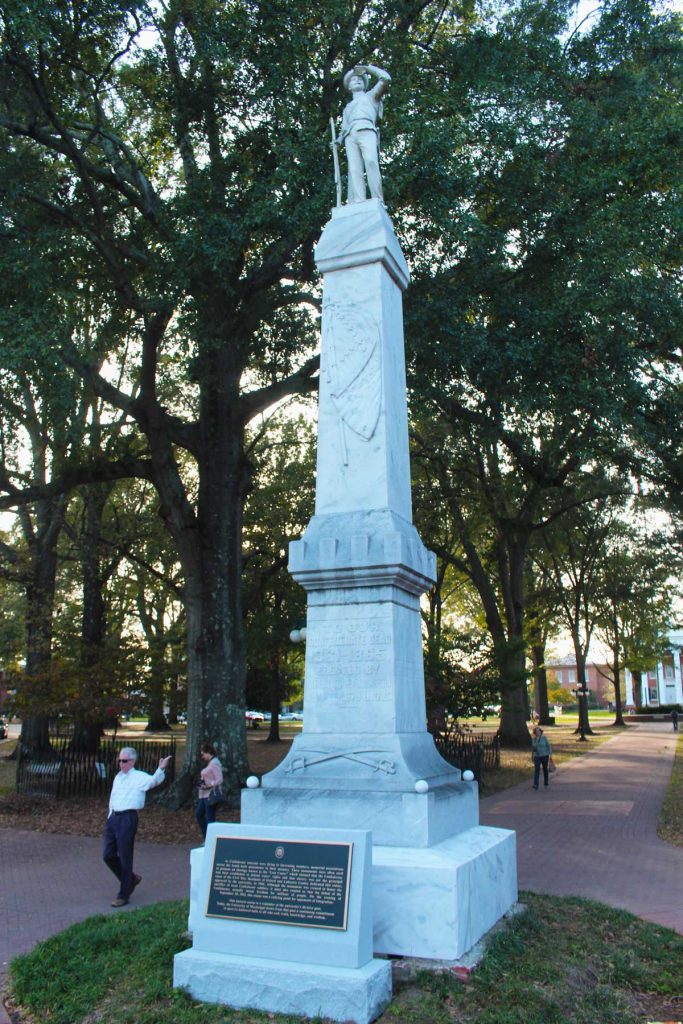
The contextualization plaque and decorative base of the Confederate statue in the Circle were fixed after a driver crashed into them earlier this semester. Photo By Taylar Teel
Debates surrounding Confederate monuments and their potential messages of history and racism have intensified across the country, and Oxford and Ole Miss now find themselves at the center of it all regarding the possible relocation of Confederate statues.
A recent opinion issued by Deputy Attorney General Mike Lanford said statues could be relocated as long as it remains on public, county property. The opinion applies to both the statue located on the Square near the courthouse and the memorial in the Circle.
In a statement to The Daily Mississippian, Ryan Whittington, assistant director of public relations for social media strategy for the university, said the attorney general’s letter will have no effect on the work the Chancellor’s Advisory Committee on History and Context is doing.
“As an educational institution, our guiding principle is that we have a duty to learn and teach from history, and contextualization was determined to be the most effective approach for our campus. We feel that contextualization, properly done, is an additive process and is an important extension of our university’s responsibility to educate. The Attorney General’s letter of October 2, 2017 to the Lafayette County Board of Supervisors does not change the university’s approach of contextualization.”
Lee Tyner, the university’s attorney, declined to comment on the university’s plans based on the opinion.
Katrina Caldwell, vice chancellor for diversity and community engagement, said the decision to keep the statue in its original location means the community must now prove it doesn’t condone the racism some associate with Confederate memorabilia.
“We now have a duty to engage our community in ways that make it clear that the perceptions of race that were formulated and defended during that era no longer have a place on our campus,” she said.
After the August protest over Confederate statues in Charlottesville, Virginia, the Board of Supervisors called a meeting, during which Oxonians in favor of and against the statue presented their opinions.
Some residents said they think items like Confederate flags and statues should be in a museum, while others argued the statue downtown has been a part of Oxford since 1907 and serves as a memorial to those who died during the Civil War.
The residents’ concerns prompted the Board of Supervisors to request an opinion from the attorney general’s office about relocating the statues.
The attorney general’s response said memorials to any war may not be entirely removed, only relocated to an equally prominent area in the county.
“In the case of the county, for example, a monument may be ‘moved’ within the county jurisdictional limits to some other more suitable location on county property,” the opinion said.
At Monday’s Board of Supervisors meeting, President Jeff Busby announced that a five-person contextualization committee will be formed to determine the fate of the statue and its location on the Square.
This decision is reminiscent of the Chancellor’s Advisory Committee on History and Context, established in 2016 by Chancellor Jeffrey Vitter, that works to provide context for sites on campus. One of its first projects was completed last March when the committee added a contextualization plaque to the Confederate memorial statue in the Circle.
Caldwell said the committee has helped the university understand how to move forward with understanding campus symbols, buildings and history.
“We engaged consultants and learned about strategies used by other institutions that are also working to understand their past,” she said. “As an educational institution, we have embraced an educational strategy, and only time will tell whether this educational strategy is more effective than the strategies embraced by other institutions. One thing is for sure: It is more effective than doing nothing, like some institutions have chosen to do.”
Donald Cole serves as assistant to the chancellor for multicultural affairs. He said aspects of the statue are problematic, and its prominence in the Circle has the potential to deter prospective students.
“Its size and location gives the impression that it represents the university,” he said. “Perhaps, at one time in history, this might have been the case. But as our canon, values and beliefs have developed, the statue has become increasingly more complex, misunderstood and dividing. It still has lessons to teach, and its present location interferes with its message and the lessons we want to teach.”
Cole said many people have suggested the Confederate cemetery on campus as a more suitable location for the statue.
Cole also said that while the university’s dedication to contextualization is a good first step, there is still work to be done in educating students on what they can learn from the statue.
“We all share in improving the comfort level of our campus, and contextualization, relocating, removal, renaming, balancing or altering will not compensate for change of heart resulting from additional knowledge gained, research conducted, sound reasoning applied and a deep desire to discover the truth,” Cole said.
Both Caldwell and Cole said it is important to learn from the mistakes of the past to ensure a better future for the state and the university.
“It is important to connect with each other to understand and convey that while our state and campus have some painful eras in history, we must work together to ensure that the abhorrent aspects of that history do not define our state or university,” Caldwell said.






